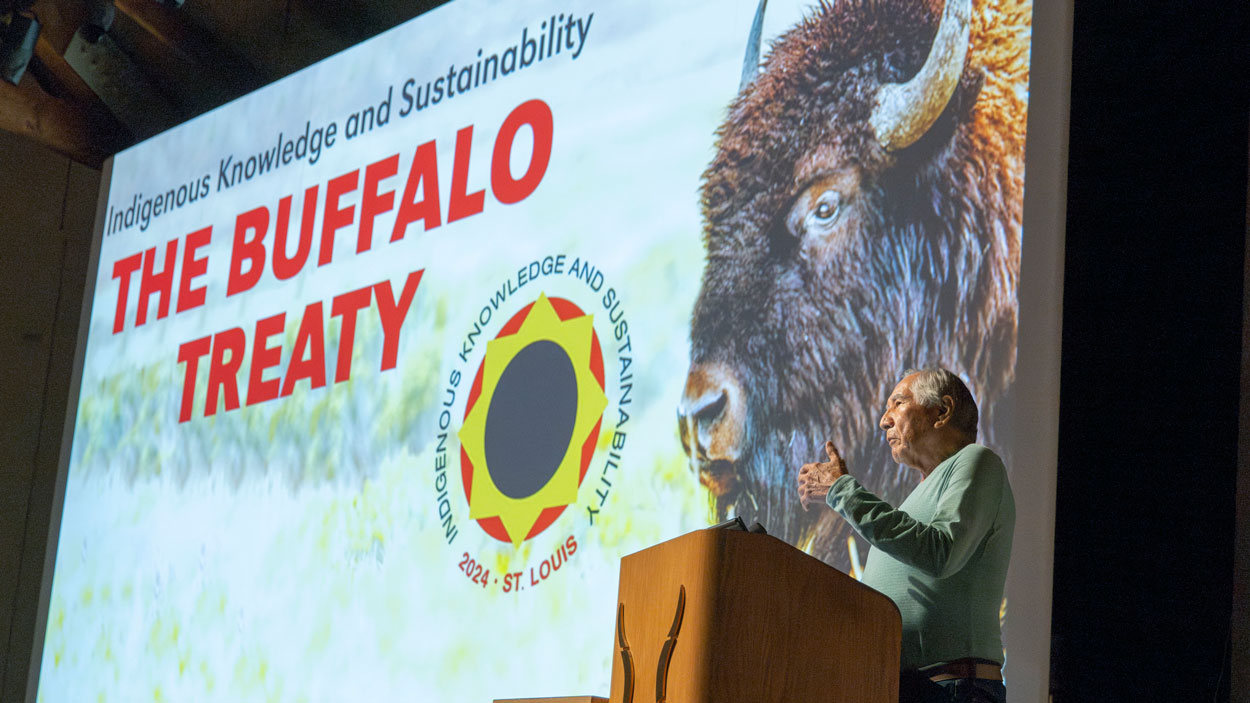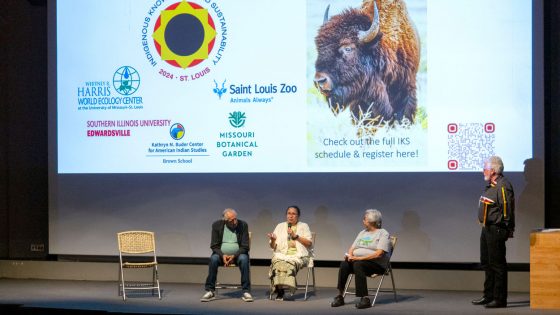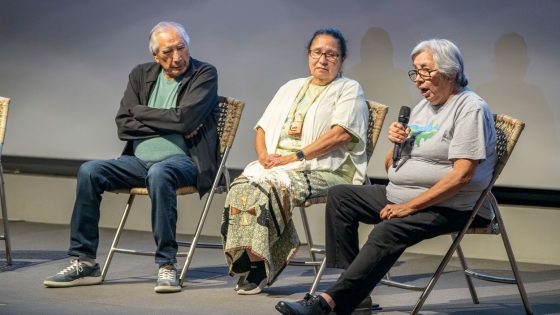
Leroy Little Bear speaks about the creation of The Buffalo Treaty during the Whitney and Anna Harris Conservation Forum last Thursday evening in the Living World at the Saint Louis Zoo. (Photos by Derik Holtmann)
It is hard for anyone living today to imagine tens of millions of bison roaming in large herds across the plains of North America.
But Thursday’s annual Whitney and Anna Harris Conservation Forum, focusing on the Buffalo Treaty, served to highlight the critical role the animals occupied in the prairie ecosystem for thousands of years as well as how integral they were to the lives and culture of many Indigenous people who depended on bison for their well-being and survival.
“Think about this buffalo as a keystone species,” said Leroy Little Bear, one of three featured speakers during the event hosted by the Whitney R. Harris World Ecology Center at the University of Missouri–St. Louis. “When we’re talking about a keystone, we’re talking about, in architecture, that stone that holds everything else up and that everything rests on.”
The decimation of bison in the 1800s brought a profound loss for both the land and its people, who found themselves under further threat as they were moved onto reservations and pushed to assimilate into American society. That pressure took a particularly sinister turn toward the end of the 19th century when an estimated 100,000 Indigenous children were separated from their families and forced to attend boarding schools where they were forbidden from speaking native languages and had to abandon native identities and renounce many of their beliefs and traditions.

Roxann Smith (center) speaks during an audience Q&A during the Whitney and Anna Harris Conservation Forum. Ed Spevak (at right), the curator of invertebrates at the Saint Louis Zoo, served as the moderator during the discussion.
Indigenous communities continue to reckon with the repercussions of those actions today as they face high rates of poverty, a lack of jobs and economic opportunity, significant physical and mental health disparities, a lack of quality education and continued cultural erosion.
As more than 150 attendees of the forum learned Thursday night in the Anheuser-Busch Theater in the Saint Louis Zoo’s Living World, the Buffalo Treaty has been an ongoing effort to restore balance and bring healing by returning bison to native lands and strengthening cultural relationships with the animals.
Little Bear, a Blackfoot educator, lawyer, author and advocate, played a central role in the creation of the treaty. It includes articles outlining the treaty’s goals for conservation, culture, economics, health, education and research.
Initially, Indigenous nations from eight reservations in the United States and Canada came together to sign the treaty in 2014, but the number of signatories has since grown to more than 60 First Nations stretching from Texas to the northern reaches of Canada and from Ontario to British Columbia. They marked the treaty’s 10th anniversary last month during a gathering on the Blood Reservation in Alberta.
Members of the Nakota and Dakota people who make up the Assiniboine and Sioux Nation on the Fort Peck Indian Reservation in northeastern Montana were the first to bring bison back onto tribal lands two years before the treaty was adopted. They maintain a traditional herd and a business herd that includes mixed cattle genes used for supplying meat for commercial use.
Roxann Smith, the project director of Buffalo Nations Landmarks program and a faculty member at Fort Peck Community College, described ongoing efforts to implement curriculum focusing on history and revitalization of the buffalo within lessons about Indigenous nations.
“We did this workshop last year after getting a grant from the National Endowment of Humanities, and I learned this word ‘rematriation,’” Smith said. “That was the first time I learned that word, and it means to bring balance to our homelands. I also have been learning a lot about how when you return buffalo to their habitat, they renew the land.
“As a teacher, you try to present these things to your students, so I also try to embed questions about some other things that were lost that need to be returned.”

Jonny BearCub Stiffarm answers a question from the audience during the Whitney and Anna Harris Conservation Forum.
Jonny BearCub Stiffarm is another member of the Fort Peck Assiniboine and Sioux Nation who helps administer its buffalo restoration efforts. She made a plea to help Indigenous tribes in their efforts as a means of repairing the ecosystem.
“There’s the responsibility of all of us as human beings to figure out ways to help the planet,” she said. “One of the ways you can help land is helping these tribes be able to access land to expand their herds, whether that’s national park land or whatever type of land that is out there.”
For Stiffarm, who was 35 the first time she saw a live bison – in a zoo – and who waited until she was about 50 to first taste buffalo meat – at a Ted’s Montana Grill – she knows restoring the buffalo is also a way to strengthen people’s identity.
“I think the most important thing that the buffalo have done for us is in our mental health,” she said. “I can testify before you that our mental health has dramatically improved. The pride of our young people in our identity, the pride and knowledge that they belong to something important, that they have a relationship with something they can see, really makes a huge difference.”
Thursday’s conservation forum doubled as a kickoff for the second Indigenous Knowledge and Sustainability Series, which the Harris Center co-hosted with the Native American Studies Program at Southern Illinois University Edwardsville, the Kathryn M. Buder Center for American Indian Studies at Washington University in St. Louis, the Missouri Botanical Garden and the Saint Louis Zoo.
The series, first held in 2021, was created to explore what lessons about conservation today’s society might glean from Indigenous peoples, who maintained a more harmonious relationship with the world around them.
The series continued with a discussion Friday at SIUE titled “Humans, Nature and The Buffalo Treaty,” featuring the same speakers. Friday evening, the Buder Center organized screenings of two films, “Singing Back the Buffalo” and “Iniskim – Return of the Buffalo,” at UMSL’s Blanche M. Touhill Performing Arts Center. Amethyst First Rider, who directed the “Iniskim,” took part in a discussion with Little Bear and author Wes Olson afterward.
The series concluded Saturday at the Missouri Botanical Garden with an event exploring the “Ecological Buffalo,” with a keynote from Stiffarm on “Keystone Species & Sovereignty = Rejuvenation, Innovation and Wonder.” Olson and photographer Johane Janelle were also on hand to discuss their book “The Ecological Buffalo: On the Trail of a Keystone Species.”














